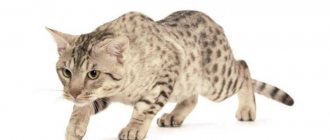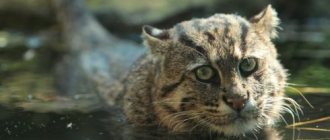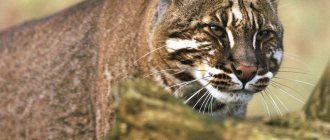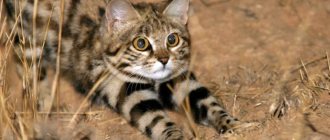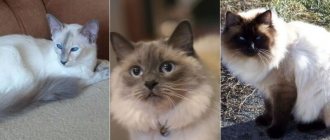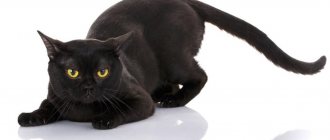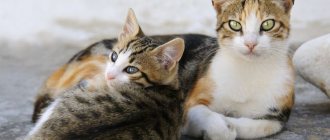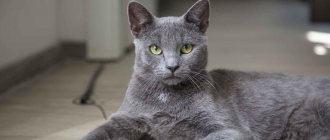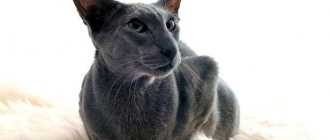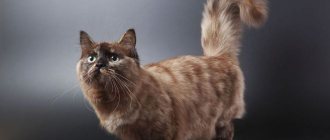Origin story
The Ocicat was born solely at the behest of restless breeders, namely thanks to felinologist Virginia Dale, who suddenly wanted to breed a cat similar to the Siamese, but with a different coat color. For the work, Siamese and Abyssinian cats were taken, respectively, but at some point things took an unexpected turn and an amazing-looking kitten was born: with cream-colored fur, strewn from head to toe with bright contrasting spots.
The cat was named Tongo and, after a while, was put up for sale at a symbolic price. Virginia continued her work, but in a different way: she really liked the spotted color. The next speckled baby, Dalai Dotson, has already received CFA registration.
Over the course of several years (from 1966 to 1980), another hundred spotted babies were born. Others also joined in the breeding of the new breed: American shorthair cats. In 1984, the first breed club was opened, and 2 years later Ocicats won the status of CFA championship.
Also in 1986, the CFA imposed a ban on crossing Ocicats with their close “relatives”: Abyssinian, Siamese and American Shorthair breeds.
Standards
Males of the Ocicat breed look larger in appearance than females and are not as graceful. They weigh about 7 kg, girls - 4-5 kg.
| Standard | Description |
| Head | Wedge-shaped, the skull is elongated in profile, with strong jaws and a clearly defined chin. The whisker pads are plump, and the depression between the pads and cheekbones is also visually noticeable. |
| Ears | They are small, stand upright, and their tips can be decorated with tassels. |
| Eyes | Almond-shaped, open, the color of the iris can be any (one exception - all shades of blue). |
| Torso | Dense but elegant. Outwardly, the animal seems lighter than it actually is. The chest is wide, the back is straight (a small hump between the lumbar region and the croup is allowed). |
| Limbs | Long, muscular. The paws are elongated, with 4 toes on the hind legs and 5 on the front ones. The tail is long and pointed at the tip. |
| Wool | Smooth, very thick and pleasant to the touch. Be sure to tick all hairs. |
Signs due to which an animal is removed from the competition:
- Long or fluffy coat.
- A different color (for example, all shades of red, torby, cream).
- Different number of fingers.
- Blue eyes.
- Tail with loops or creases.
- White fur (exception: in the throat, chin, around the eyes and nostrils).
Conclusions about the breed
Getting to know an Ocicat cat usually begins with an admiring “Ah!” No one is surprised at this reaction, because the cat’s appearance is actually impressive with its grace and the beauty of its fur coat. Is it worth giving your heart to this breed? Let's summarize:
- The appearance of the animal consists of an ideal combination of shape and color;
- It’s easy to organize meals by choosing a suitable balanced food;
- No extensive grooming is required. Brushing a couple of times during the shedding period does not count;
- The activity of the animal needs encouragement: the pet requires attention and communication in any form. A cat is not suitable for people who disappear for days at work;
- The animal's friendliness makes it easy to bring it into a house full of people;
- Proper nutrition and active play will help keep your cat in good health.
Has the Ocicat captivated you? Such a cat certainly does not cause indifference! Let's hope that soon more nurseries specializing in this beautiful breed will appear in Russia.
Colors
According to the standard, 12 acceptable colors are established: chocolate, chocolate-silver, brown, brown with red, brown with yellow, brown-silver, lilac, lilac-silver, blue, blue-silver, beige-silver, black with silver.
The spots on the tail, paws and muzzle should be noticeably darker than the marks on the body. There is a letter "M" on the muzzle. The eyes are outlined in black. The tails of purebred individuals have contrasting transverse stripes.
In the photo there are Ocicat cats of popular colors: red, blue-gray, beige
How to choose a kitten
- Make sure that the color of the animal matches the shades specified in the standard. If the seller offers a spotted kitten of any unticked color, it is anyone but an Ocicat.
- The champagne shade, as well as the silver-blue, silver-lilac and fawn-silver colors are considered the rarest, so you will have to pay more for an Ocicat of this color.
- The most common colors of the breed are all shades of chocolate. So, when buying a brown cat, you can count on a small saving - the price tag for blue and lilac cats is much higher.
- If the character of the Ocicat is important, and not its exhibition career and breeding characteristics, you can opt for varieties of the breed - cats with ticked fur without marks, individuals with solid colors in which the spots merge with the background, and beauties in marbled “fur coats” (those Aztec cats).
- Pay attention to the behavior of the kittens when you arrive at the nursery. If babies hiss, run away and do not come out of hiding for a long time, this indicates instability in the psyche of the offspring, which is most likely inherited from their parents.
Character and behavior
A nimble traveler, knee-deep in the sea - this is how you can briefly describe the Ocicat. Climb higher, run further, find out what is hidden around the next bend and behind that mountain: as they say, don’t feed the Ocicat bread, but let it go free-range, where it will be its own master. However, this cannot be done not only because they will immediately try to steal such a beautiful cat, but also because the fearless Ocicat does not know how to assess risks and can easily get into an unpleasant and even dangerous situation. Approach, for example, a clearly aggressive dog. Or try to jump from a great height.
Representatives of this breed are very affectionate towards people and do not hesitate to show their love and devotion. Of all the family members, he chooses one - the most important for himself - and will remain faithful to him until the end of his life. He also loves other people living side by side with him, but not so selflessly.
He is not afraid of strangers, does not shy away from guests. Even a noisy crowd is not able to embarrass him or force him to hide. He knows how to “talk for life”, and always does it on time. Ocicats subtly sense human mood and, if you clearly have no time for conversation, will quietly sit on the sidelines, waiting for a signal. He does not tolerate loneliness well, even in the company of other cats he quickly becomes bored. The main thing for him is the person, his words and hands.
Ocicats get along with both cats and dogs, but a couple of Ocicats can create an unimaginable mess in your home, so decide what is more important to you: 2 adorable cats or renovation?
If the Ocicat finds an empty bowl, he will not follow you and demand food, but will calmly begin to rummage through the plates and pots that are available to him, try to open the refrigerator or chew on a bag of food.
Ocicats do not become attached to a place and easily tolerate moving. But what they can’t stand is carriers and collars. In the process of accustoming the animal to both the first and second, you will have to be patient.
The same goes for learning tricks. Ocicats quickly grasp information and are happy to do what they like. Babies learn most quickly if there is already an adult and trained animal in the house.
Ocicats are naturally clean and have no problems with the litter box. But if they think their toilet smells bad, they will refuse to go there.
You can also buy an Ocicat kitten in Russia - there are several nurseries in our country - but the cost of one individual will be high. If you are offered an Ocicat kitten for less than 50,000 rubles, this is most likely a scam. But if you want to be sure of the breed: buy a kitten from a foreign nursery.
Education and training
It is customary to write about the learning abilities of Ocicats only that they are smart and quick-witted pets who can easily fetch objects and simple acrobatic tricks. At the same time, it is extremely rare to find information that, like any cats, the descendants of Siamese and Abyssinians are not eager to obey a person and train simply because the owner demands it.
If you decide to get serious about training your Ocicat, come to terms with the need for compromises, which you will have to make often. Some breeders generally recommend relying on the inclinations of the breed, since by stimulating the cat to do what he obviously likes, you dramatically increase your chances of success. For example, Ocicats love to jump, which means that it will not be difficult to teach your pet to take small barriers and fly through a hoop.
The Ocicat has a good memory and excellent self-learning abilities, inherited from the Abyssinians, so the cat quickly learns a list of basic commands. In order for your pet to learn to comply with the requirements “Come to me!”, “Sit!”, “Stand!”, a classic training program is sufficient. Special literature, for example, the book “Training a Cat in 10 Minutes” by Miriam Fields-Bambino or “How to Train Your Cat” by Ellis Bradshaw, will also help you broaden your horizons and learn new techniques for effectively influencing an animal.
Raising a small kitten is easier when a trained adult cat already lives in the house. Submitting to the animal hierarchy, the baby mirrors the behavior of an adult comrade and makes fewer mistakes. If the Ocicat is the only pet in the apartment, the owner will have to take on the role of mentor. As for toilet training your pet, there are no difficulties here. Michigan cats are naturally clean. If there is no usual litter box nearby (for example, on the road), they prefer to be patient or persistently remind them of their needs. Ocicat kittens brought to a new home also quickly get used to the bath with filler and willingly scratch themselves in it, hiding traces of “wet deeds.”
Care instructions
There is no need to buy any special equipment to care for your Ocicat. Nail clipper, shampoo and conditioner, cat toothbrush and toothpaste, cotton swabs, natural bristle comb, ear lotion and cotton pads.
Claws
If your pet sharpens its claws on the scratching post itself, it does not need your help. But if the kitten is small or, on the contrary, old and weak, get involved and shorten its claws 1-2 times a month. Proceed carefully, and if blood vessels are caught, cauterize the cut site with hydrogen peroxide.
Do you trim your pet's nails?
Yes, he’s lazy with us. No, he sharpens himself.
Ears
Ears should be cleaned every week as Ocicats produce a lot of wax. But do not try to pour water or lotion into the cat’s ear: this action provokes otitis media. Soak a cotton swab (whether in a special ear cleaner or in plain boiled water - it makes little difference) and remove discharge and accumulated dirt.
Eyes
Ocicats' eyes rarely run. If the discharge is clear and small, there is no cause for concern. Wipe them from time to time with warm chamomile decoction. But if there is copious, thick or foul-smelling discharge, be sure to take your pet to the doctor.
Wool
Combing once a week is enough. Before the exhibition, the fur can be lightly rubbed with a suede cloth - this procedure will add shine to it.
Teeth
Since the teeth of Ocicats are the weakest point, their care should be thorough and regular.
First, they need to be brushed 2-3 times a week using a small toothbrush and cat toothpaste. Secondly, give special cleansing pads every week for prevention. Thirdly, take him to the veterinary office for ultrasonic teeth cleaning.
Care and feeding of cats
This is the same breed that does not require any special care. The coat requires attention only during shedding. The rest of the time, you don’t even need to comb it, the fur coat is good on its own. There is no undercoat, this eliminates a number of maintenance problems. If you really want to, you can polish the fur with a piece of suede.
It is very necessary to organize a place for games: the animal’s energy often goes through the roof. For health, the cat needs to be walked and engaged in active games.
Proper feeding of an Ocicat includes high-quality, balanced food. You don’t need to look for any recipes, this will be enough. Accordingly, there should always be clean, fresh water in the bowl.
Catering
Active Ocicats do not suffer from lack of appetite and are not prone to obesity. But this does not mean that you can feed them anything and put huge portions in bowls “in reserve.” The basic rules are:
- Food for the Ocicat should be coarse enough to remove plaque from the teeth and massage the gums.
- Animal protein – at least 70%.
- For castrated and sterilized animals, the amount of carbohydrates should be kept to a minimum.
- Water is the only thing you can give an Ocicat. It must be clean (bottled, settled, or passed through a special filter), at a comfortable temperature, and odorless. Wash the bowl and change the water 2 times a day: morning and evening, and when it gets dirty.
- Do not mix natural and prepared food: this creates additional stress on the digestive system. Choose one thing.
Natural products
You need to be able to choose the right products, prepare them properly, know in what quantities and to whom to give them.
You cannot feed cats food from your table: fatty, sweet, salty foods, it is forbidden to give smoked meats, many vegetables (eggplants, pure potatoes, tomatoes), legumes, juices, citrus fruits, baked goods, canned food, seasonings, sugar, salt, sauces, alcohol, products with preservatives and additives. And chocolate and eggplants are deadly for cats, as are tubular bones!
List of permitted products:
- Fish (salmon, trout, chum salmon, cod, tuna, pink salmon, flounder, halibut, sardine). Scales, fins and heads are removed from the fish, frozen for 2-3 days before consumption, then cut into pieces and boiled or served raw. You can’t give it more than once a week: excess iodine leads to hyperthyroidism, histamine – to allergies, fatty acids – to inflammation and panniculitis.
- Lean meat and offal (beef tenderloin, veal, chicken necks and breasts, rabbit, turkey, kidneys, liver, hearts, horse meat, soft cartilage). Meat, like fish, is frozen and then doused with boiling water or boiled.
- Low-fat dairy products (cottage cheese, fermented baked milk, cream, kefir, yogurt, sour cream, natural yogurt).
- Porridge (buckwheat, oatmeal, pearl barley, millet, rice). Boil in water, do not add sugar, salt or seasonings. You can add milk, but not much (solely for taste).
- Boiled chicken eggs (yolk), quail eggs (whole).
- Vegetables (pumpkin, carrots, zucchini, asparagus, broccoli, green peas, cauliflower, spinach, beets, squash, parsley, green salad, dill, cucumbers).
Recommended food
Industrial ready-made food is often chosen by owners who, due to their busy lives, cannot devote much time to cooking and counting nutrients. But there are so many bright packages on store shelves that it is sometimes difficult to make a choice.
But don't believe the advertising! If you have the financial opportunity, buy holistic food for your pet. They are the most expensive, but the quality is an order of magnitude higher than all the others. For their production, high-quality products, natural preservatives, high-quality vitamin and mineral supplements are used, and there are no dangerous chemical compounds, flavor enhancers or dyes. Examples: Power of Nature, Wellness CORE, Now Fresh.
Super-premium food is a little cheaper. The composition is somewhat different from holistic food: pea or potato protein and rosemary are often added to super-premium food as a preservative. Examples: Mealfeel, Natyka, Pronature Life, Summit.
Below are the recommended holistic and super-premium foods. Links with the names of the food are clickable, on them you can, within our website, get acquainted with the descriptions of the food and read reviews from owners of Ocicat cats.
| Super premium | Holistic | Super premium |
| Pure Life | Alleva Holistic | VetSolution |
Diseases
By cat standards, Ocicats live a long life: 15-18 years. But they have genetic problems, which is not surprising: after all, when breeding the breed, as many as 3 breeds of cats were used!
- Firstly, renal amyloidosis is often diagnosed in Ocicats. This disease is quite rare, but very dangerous: the body stops processing protein correctly. Metabolism is disrupted, the kidneys suffer, and renal failure occurs. The animal loses weight, weakens, its urine becomes thick with blood, constipation or diarrhea appears, the temperature rises, the hair becomes dull and falls out. It is impossible to cure the disease, but it is possible to alleviate the cat’s condition, as well as extend life for several years.
- The second problem is pyruvate kinase deficiency (PK-Def) - an autosomal recessive disease, anemia, in other words. Symptoms vary (lack of appetite, weakness, weight loss, drowsiness, spleen tumor). Medicines improve quality of life.
- The third problem is gum disease (gingivitis). It was transmitted to Ocicats from both Abyssinian and Siamese cats. Gingivitis leads to tooth loss, so preventive measures must be followed very strictly.
Expert opinion
Dusheba Vera Ivanovna
In 2010, she graduated from the Moscow State Academy of Veterinary Medicine named after K.I. Scriabin with honors, specializing in veterinary medicine. I regularly attend veterinary conferences, congresses, and webinars.
The deworming procedure should be carried out even if your cat does not go for walks. Worm eggs can enter his body even with food (through chicken, pork, fish), from your outdoor shoes, or through fleas. Medicines should be given only after consultation with a veterinarian, since the age, weight, and general condition of the animal are taken into account (medications should not be given to kittens under 20 weeks of age, and with extreme caution to lactating cats and pregnant women).
All of the above applies to vaccination. Diseases such as panleukopenia, rhinotracheitis, calcivirosis, rabies and others are deadly for cats. For some time, kittens are protected by mother's milk, but when they reach the age of 16 weeks, the effect disappears. Vaccination provides lasting immunity and reliable protection, but you shouldn’t give your cat injections yourself - trust this matter to your doctor!
Diseases of the Ocicat cat breed
The genetic pool and potential of representatives of this breed is quite good, and cats rarely get sick.
However, even such a hardy and healthy group is characterized by a number of specific diseases:
- Hypertrophy of the heart muscle, which is accompanied by the development of heart failure.
- Renal amyloidosis, which is manifested by sudden weight loss, constant thirst, and problems with urination.
Another genetically determined disease is a deficiency of a number of oxidative enzymes, which can be suspected when there is a decrease in appetite with a simultaneous enlargement of the abdomen.
Photo gallery
Below are photos of Ocicat cats.
